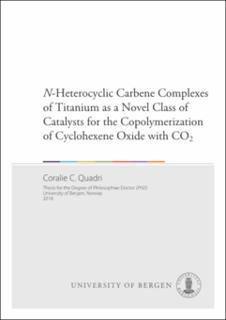N-Heterocyclic Carbene Complexes of Titanium vel Class of Catalysts for the Copolymerization of Cyclohexene Oxide with CO2
Doctoral thesis

Åpne
Permanent lenke
https://hdl.handle.net/1956/17643Utgivelsesdato
2018-04-27Metadata
Vis full innførselSamlinger
- Department of Chemistry [433]
Sammendrag
Regarding environmental, economic and political issues, the utilization of CO2 as C1 chemical feedstock has received a worldwide interest in the last decade. Indeed CO2 is considered as a greenhouse gas (submitted to strict regulations), alongside being an optimal raw material (renewable, nontoxic, nonflammable, safe, cheap and naturally abundant). A promising large-scale application is its use as a co-reagent in polymerizations. The copolymerization of CO2 with epoxides is an attractive alternative for the production of polycarbonates for instance, that are not oil-based and avoiding the use of toxic reagents such as bisphenol A and phosgene. Since the early ’70s, a range of catalysts based on different metal centers (essentially Zn, Al, Mn, Cr and Co) and bearing a variety of ligands (mostly phenoxide, 1- diiminate and salen type) has been reported, showing high activity and selectivity toward the coupling of CO2 with various epoxides. However, the range of active metal centers and ancillary ligands reported remains surprisingly narrow. Moreover, the development of new greener and competitive catalytic systems for the copolymerization of epoxide with CO2 is necessary to support a viable sustainable process at reasonable cost. Our focus was to develop complexes based on non- endangered, abundant, inexpensive and nontoxic metal centers, which are active and selective for the production of polymers under mild reaction conditions. The potential of a new family of precursors based on the oxygen-functionalized N-heterocyclic carbene (NHC) ligand combined with titanium as catalyst component for the copolymerization of cyclohexene oxide (CHO) with CO2 was investigated. Tridentate and bidentate NHC titanium complexes were synthesized and fully characterized. Upon cocatalyst addition, all the tridentate NHC titanium complexes were found to be active and highly selective toward the formation of poly(cyclohexene carbonate), while bidentate NHC titanium showed no activity. Further, the reactivity of those catalytic systems and the reaction conditions (nature and ratio of cocatalyst and coligand, catalyst loading, use of additional solvent, CO2 pressure and temperature) were investigated. These studies allowed to improve the understanding of the active species, optimize the reaction conditions and design new and/or modified systems, tridentate NHC titanium azide being the pre-catalyst leading to the highest activity toward the coupling of CHO with CO2 under low CO2 pressure. These systems were the first tetravalent NHC titanium catalysts reported for the copolymerization of CHO with CO2.
Består av
Paper I: “Copolymerization of Cyclohexene Oxide with CO2 Catalyzed by Tridentate NHeterocyclic Carbene Titanium(IV) Complexes” Quadri C. Quadri and Erwan Le Roux Dalton Transactions 2014, Vol. 43, pp 4242-4246. Full-text not avialable in BORA. The published version: https://doi.org/10.1039/c3dt52804aPaper II: “Structural Characterization of Tridentate N-Heterocyclic Carbene of Titanium(IV) Benzyloxide, Silyloxide, Acetate and Azide Complexes and Assessment of Their Efficacies for Catalyzing the Copolymerization of Cyclohexene Oxide with CO2” Coralie C. Quadri, Ralte Lalrempuia, Julie Hessevik, Karl. W. Törnroos and Erwan Le Roux Organometallics 2017, Vol. 36, pp 4477-4489. Full-text not avialable in BORA. The published version: https://doi.org/10.1021/acs.organomet.7b00705
Paper III: “Steric Factors on Unsymmetrical O-hydroxyaryl N-Heterocyclic Carbene Ligands Prevailing the Stabilization of Single Stereoisomer of Bis-Ligated Titanium Complexes” Coralie C. Quadri, Ralte Lalrempuia, Karl. W. Törnroos and Erwan Le Roux. Submitted version. http://hdl.handle.net/1956/17645
Paper IV: “Di-❍-chlorido-bis{bis[N,N-bis(trimethylsilyl)amido]-titanium(III)}” Coralie C. Quadri, Karl. W. Törnroos and Erwan Le Roux. IUCrData 2017, Vol 2, pp x171488- x171490: http://hdl.handle.net/1956/17644